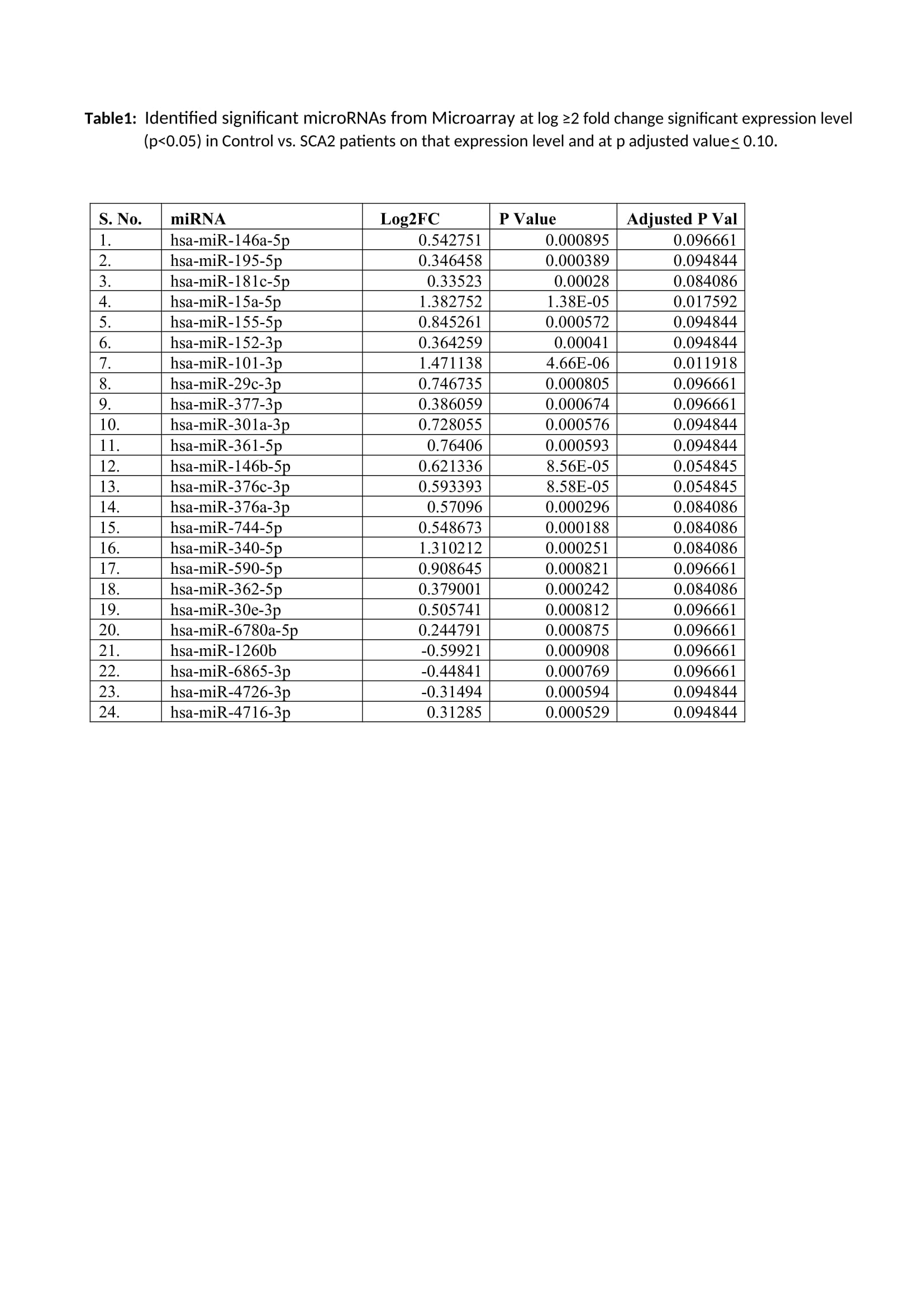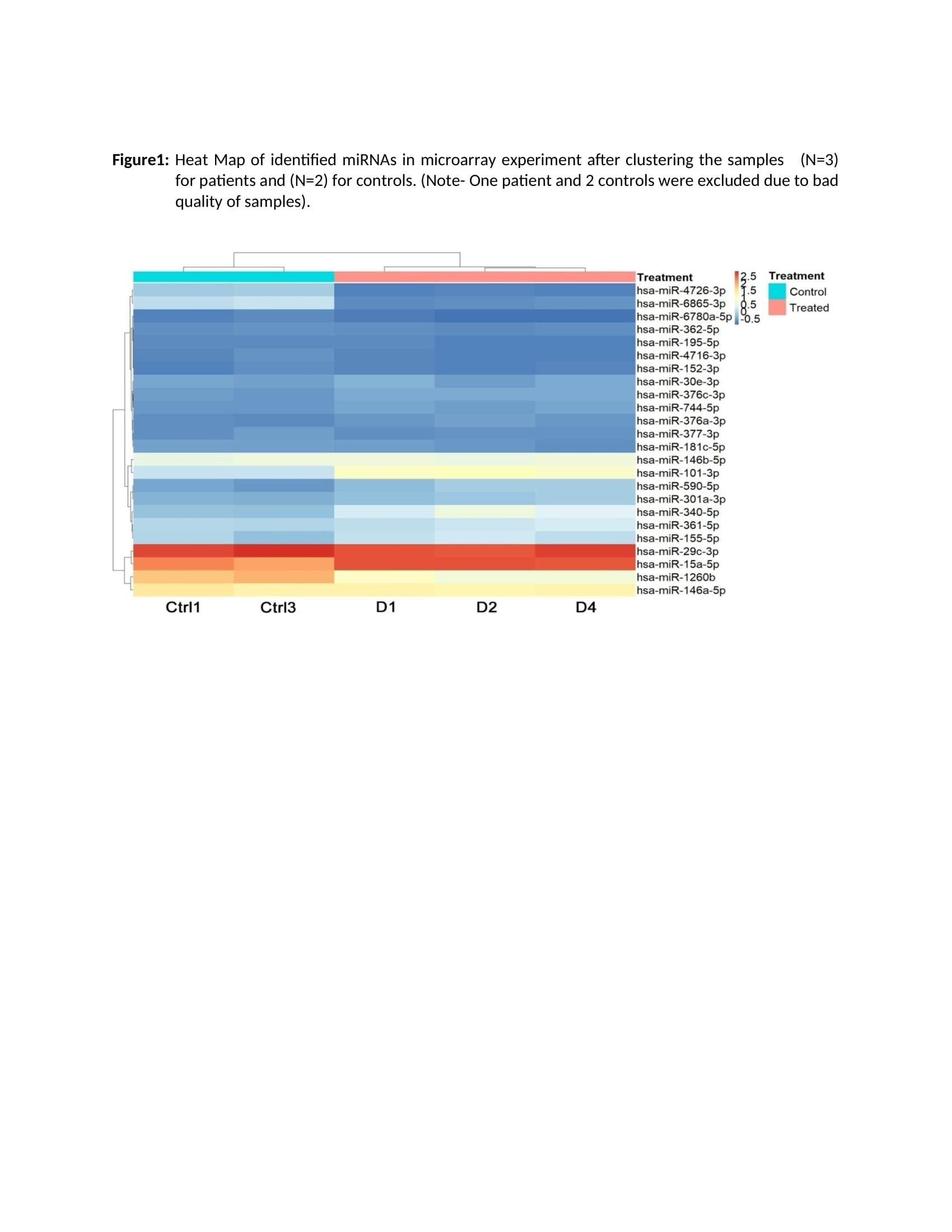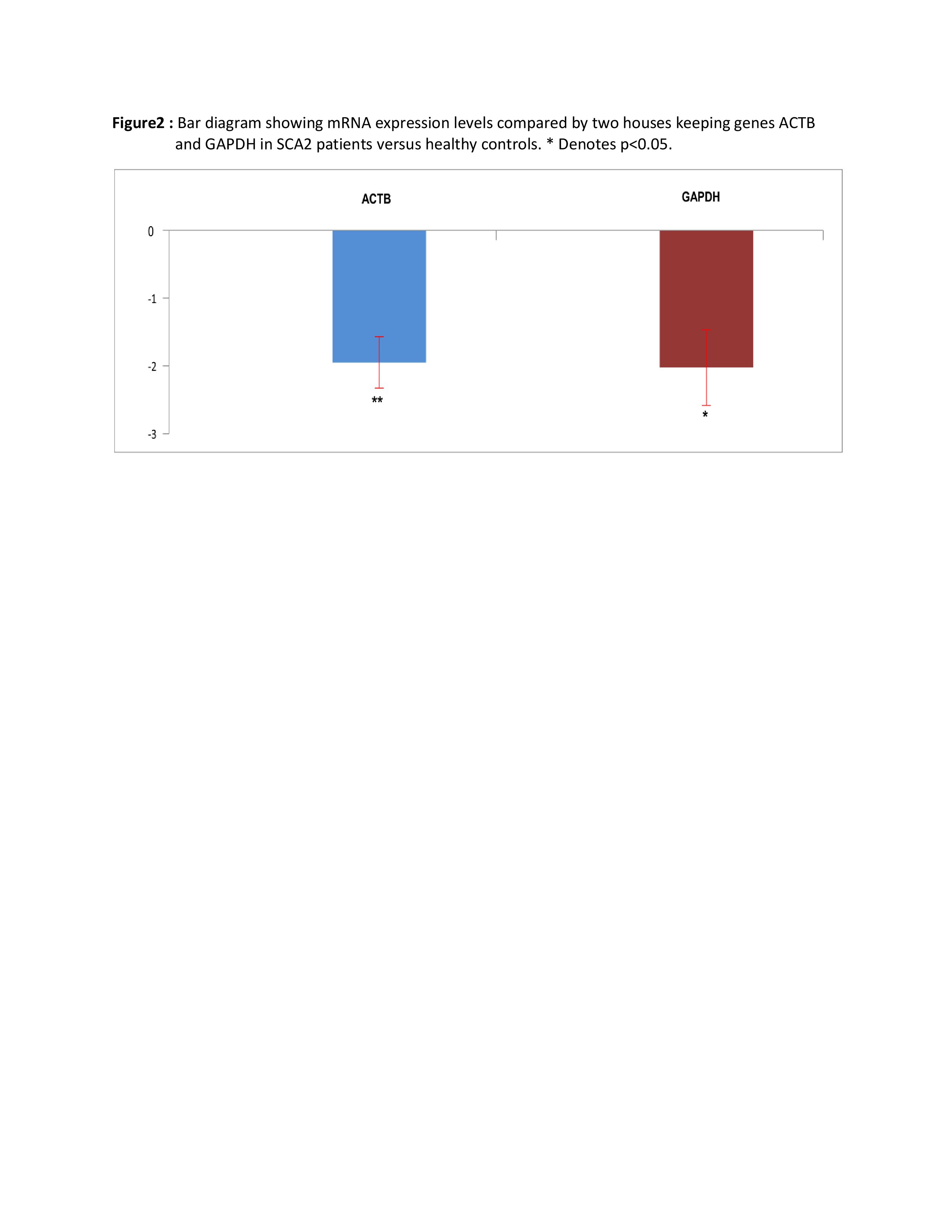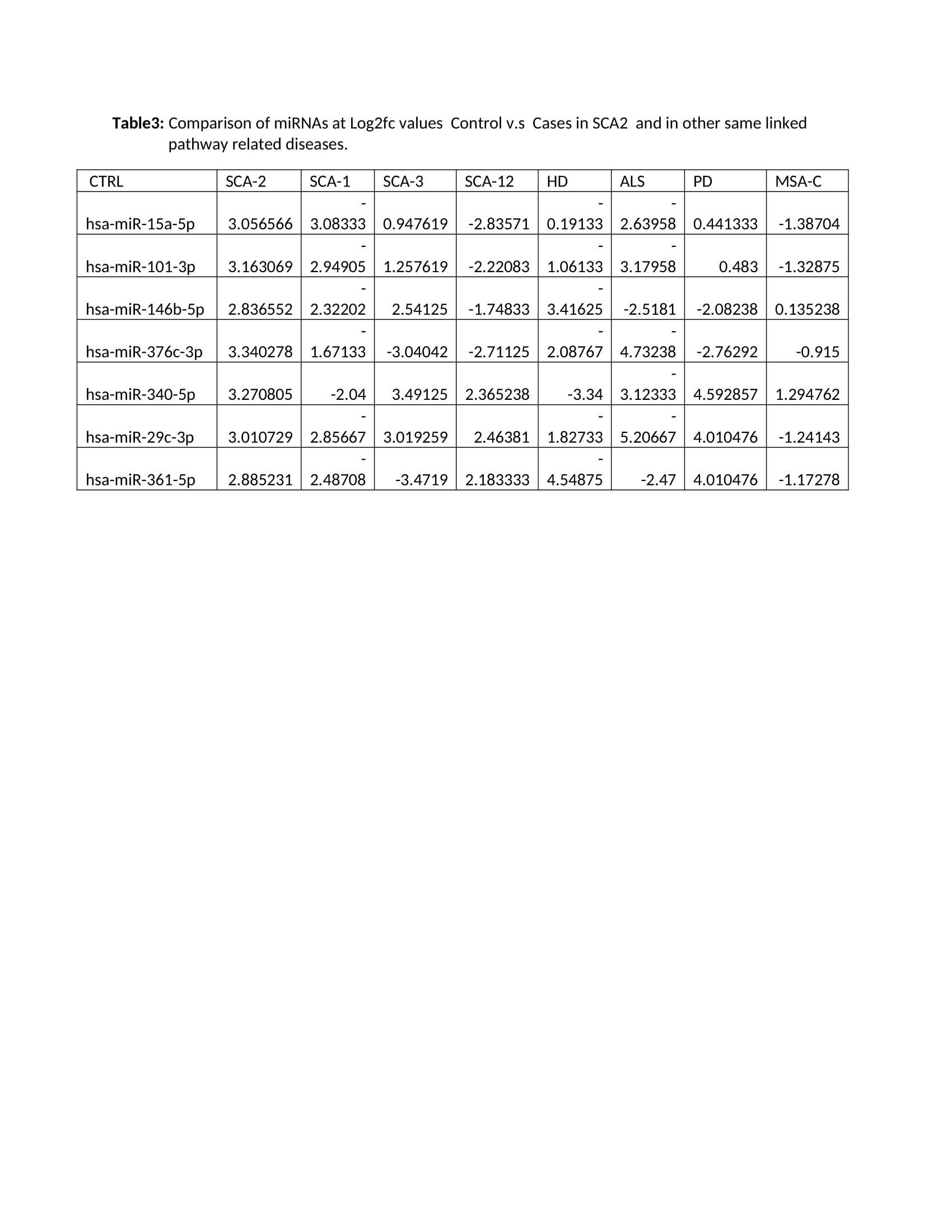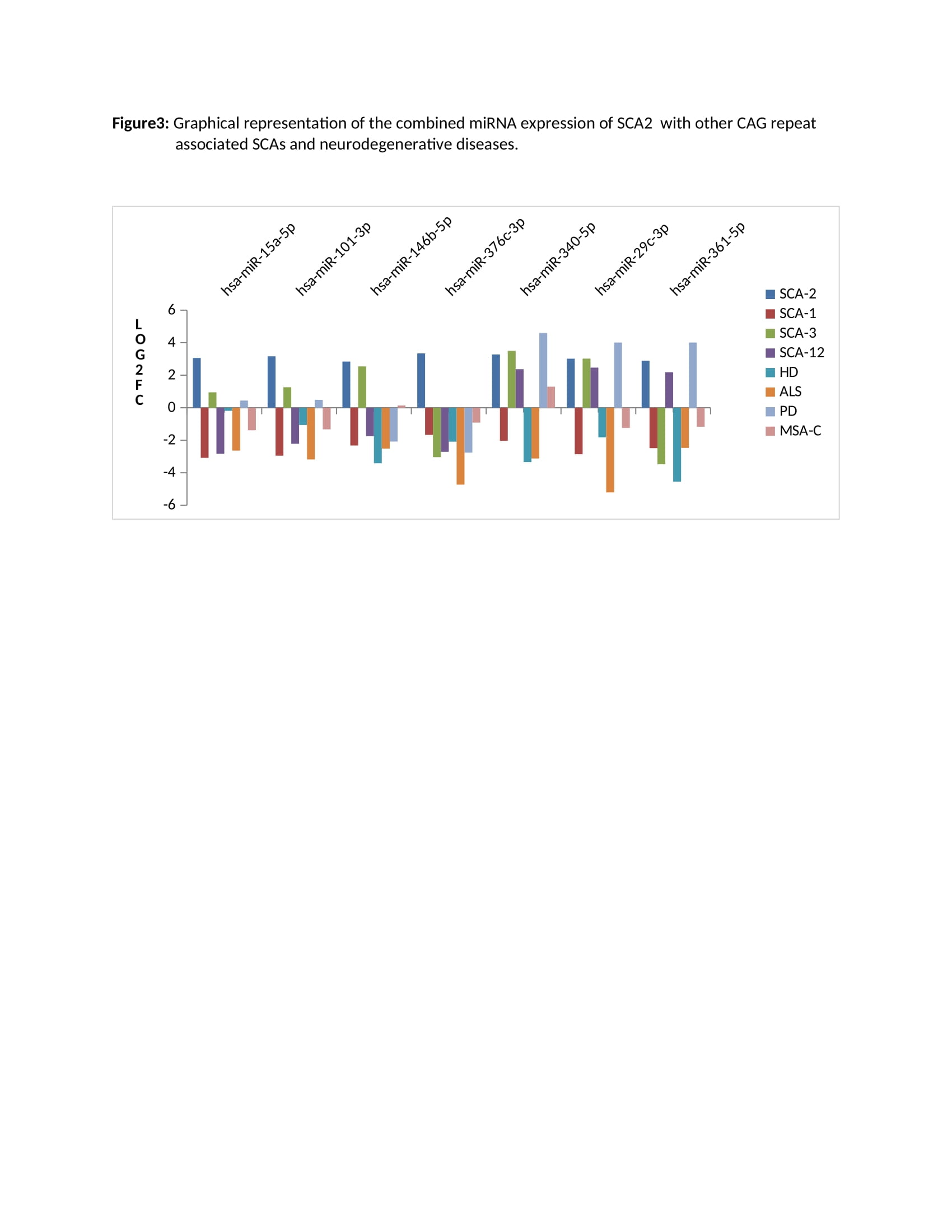Category: Ataxia
Objective: 1.Identification of microRNA in whole blood PBMCs of SCA2 patients .
2.Target prediction and pathway analysis of spinocerebellar ataxia type 2 identified miRNAs.
3.Validation of microRNAs in SCA2 and related neurological pathways associated diseases.
Background: The non-coding RNAs known as microRNAs have a length of about 22 nucleotides, play a vital role in gene regulation by suppression or degradation of its target mRNAs. Which have been identified as being present in certain neurodegenerative illnesses, but have not yet been linked to the India’s most prevalent spinocerebellar ataxia type-2 ? [1, 2, 3,4].
Method: Total RNA of four SCA2 patients and four matched healthy controls were isolated from whole blood PBMCs and analyzed for differential miRNA expressions using Human-miRNA-Microarrays. The F-test applied to find the significant miRNAs at p adjusted value< 0.10[5,6]. After target prediction and pathway analysis, ATXN2 mRNA expression (N=19 cases vs. N=19 controls) and selected miRNAs were validated using qRT-PCR method in SCA2 (N=36 cases vs. N=36 controls) and in other neurodegenerative diseases (N=10 cases vs. N=10 controls) in SCA1, SCA3, SCA12, HD, ALS, PD and MSA-C.
Results: In miRNA identification experiment we have found 24 deregulated miRNAs [Table1 & Figure1]. In target prediction and pathway analysis we have identified 7 most significant miRNSAs (hsa- miR-15a-5p, hsa-miR-101-3p, hsa-miR-146b-5p, hsa-miR-376c-3p,hsa-miR-340-5p,hsa-miR-29c-3p and hsa-miR-361-5p) which targets the genes (JAK2 , BTG2, OXR1, VEGFA,SET, HIPK2, NTF3, ROCK1, NRAS, CPEB4, GCLM, ATP7A, CHL1, NR4A2, KRAS, JUN, HIF1A, NR4A3, NRP1, TFAP2B, PIK3CA, GABRB2, SLX4, CPEB2, CPEB3, ZFP36L2, RTN4, RAB10, RAB18, REEP1, RTN3). The down regulation of mRNA of ATXN2 gene[Figure2] and up regulation of 4 exclusive miRNAs, hsa- miR-15a-5p, hsa-miR-101-3p, hsa-miR-146b-5p, hsa-miR-376c-3p [Table2 & Figure3], and 3 other upregulated miRNAs, hsa-miR-340-5p, hsa-miR-29c-3p and hsa-miR-361-5p in SCA2 may be epigenetic modulators of ATXN2 gene which may suppresses mRNA expression of ATXN2 gene in SCA2 disease.
Conclusion: So, based on these findings a novel hypothesis has been developed with experimental evidence of SCA2 mRNA and miRNA expression which indicating that it may be a hazardous non-coding RNA gain of function. The gene ontology pathways showing that SCA2 specific miRNAs are linked to apoptosis and neuronal cell death [7].
Table-1
Figure-1
Figure-2
Table-2
Figure-3
References: 1. Meza-Sosa KF, Valle-García D, Pedraza-Alva G, Pérez-Martínez L (2012)Role of microRNAs in central nervous system development and pathology. J Neurosci Res 90(1):1- 12. doi: 10.1002.
2. Díaz NF, Cruz-Reséndiz MS, Flores-Herrera H, García-López G, Molina-Hernández A (2014) MicroRNAs in central nervous system development. Rev Neurosci 25(5):675- 86. doi: 10.1515.
3. Cao DD, Li L, Chan WY(2016)MicroRNAs: Key Regulators in the Central Nervous System and Their Implication in Neurological Diseases. Int J Mol Sci.28;17(6):842. doi: 10.3390.
4. Subrahamanyam Dantham , Achal K Srivastava , Sheffali Gulati , Moganty Rajeswari(2018). Differentially Regulated Cell-Free MicroRNAs in the Plasma of Friedreich’s Ataxia Patients and Their Association with Disease Pathology. Neuropediatrics. 2018 Feb;49(1):35-43.doi: 10.1055.
5. Nicolas Merienne , Cecile Meunier, Anne Schneider , Jonathan Seguin , Satish S Nair , Anne B Rocher , Stephanie Le Gras , Céline Keime , RichardFaull , Luc Pellerin , Jean-Yves Chatton , Christian Neri , Karine Merienne , Nicole Deglon (2019).Cell-Type-Specific Gene Expression Profiling in Adult Mouse Brain Reveals Normal and Disease-State Signatures . Cell Rep. 2019 Feb 26;26(9):2477-2493.e9. doi: 10.1016 .
6. Anita Annese, Caterina Manzari, Claudia Lionetti, Ernesto Picardi, David S. Horner, Matteo Chiara, Mariano Francesco Caratozzolo, Apollonia Tullo, Bruno Fosso, Graziano Pesole & Anna Maria D’Erchia (2018). Whole transcriptome profling of Late-Onset Alzheimer’s Disease patients provides insights into the molecular changes involved in the disease SCIENTIFIC REPORTS | (2018) 8:4282 | DOI:10.1038.
7. Ryohei Watanabe, Shinji Higashi, Takashi Nonaka , Ito Kawakami, Kenichi Oshima, Kazuhiro Niizato, Haruhiko Akiyama, Mari Yoshida, Masato Hasegawa and Tetsuaki Arai (2020).Intracellular dynamics of Ataxin‑2 in the human brains with normal and frontotemporal lobar degeneration with TDP‑43 inclusions. acta neuropathol commun (2020) 8:176 https://doi.org/10.1186.
To cite this abstract in AMA style:
R. Singh, V. Swarup, I. Ahmad, V. Anand, I. Singh, M. Faruq, A. Srivastava. Spinocerebellar ataxia type 2 specific microRNAs may have an effect on neurodegeneration. [abstract]. Mov Disord. 2024; 39 (suppl 1). https://www.mdsabstracts.org/abstract/spinocerebellar-ataxia-type-2-specific-micrornas-may-have-an-effect-on-neurodegeneration/. Accessed December 6, 2025.« Back to 2024 International Congress
MDS Abstracts - https://www.mdsabstracts.org/abstract/spinocerebellar-ataxia-type-2-specific-micrornas-may-have-an-effect-on-neurodegeneration/

